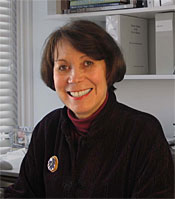|
Joan Goody FAIA, a partner in the Boston firm of Goody Clancy, died on September 8 in the converted Beacon Hill carriage house that was her longtime home. She was 73.
A Brooklyn native, Goody studied history at Cornell and architecture at the Harvard Graduate School of Design. After marrying architect and MIT professor Marvin Goody, she joined his firm in 1970 and became a partner in 1978. Marvin Goody died in 1990 and Joan later married poet and editor Peter Davison.
Among the significant projects for which she was lead designer were the renovation of Trinity Church, the H. H. Richardson masterpiece in Boston, where she created a large new “undercroft” meeting space from what had been a cramped basement, and Harbor Point, in which she transformed a deteriorated Boston public housing project into a vibrant mixed-income waterfront community.
She designed courthouses, university buildings, housing, labs, offices, and many other building types. Her firm became known not only for new architecture but for city and university planning and historic preservation. Most recently, Goody Clancy was selected as lead designer for the conversion of a historic hospital, St. Elizabeths in Washington, D.C., into a new headquarters for the Department of Homeland Security.
Having entered the field when there were few women in architecture, Goody came to be seen as a pioneer and role model for younger women. She taught a design studio at the GSD in the 1970s. She also served on numerous boards and public positions, most notably for eleven years as a member and chair of the Boston Civic Design Commission, the body that reviews all significant buildings for the city. At the BCDC she pushed for architecture that engaged the pedestrian realm and related well to traditional contexts.
She often argued for “civility.” She was a strong advocate of Boston City Hall at a time when Boston’s mayor was threatening to tear down this controversial “Brutalist” masterpiece. Her own architecture, however, was usually modest, more concerned with being livable and useful than with catching the eye. She had little admiration for show-off or whimsical design. She believed, instead, in translating moral and social values into architecture.


Post a comment to this article
Report Abusive Comment